Monsters Meet in Universal’s Shared Cinematic Universe
What’s better than seeing your favorite movie characters in a film? Seeing them together in multiple films of course!
That’s the idea of the “shared universe” in modern filmmaking where endless Star Wars spinoffs and the Marvel Cinematic Universe fill streaming services and movie theaters with endless product.
But let’s take it back about 90 years to the Universal Monsters and an early example of the shared cinematic universe, yet another movie trend with roots in classic cinema.
While more than 40 horror movies were made by Universal from the 1930s through 1950s, we tend to think of Universal Monsters in terms of the Big 5 from the early years: Dracula, Frankenstein’s monster, The Mummy, Invisible Man and Wolf Man. (That’s not to discount two other Universal franchises: The Phantom of the Opera, which first appeared as a silent in 1925, or Creature from the Black Lagoon which didn’t come along until 1954.)
The iconic monster movies were so successful that there had to be sequels. Bride of Frankenstein (1935), still one of the greatest sequels in film history, was joined by others that had various degrees of success including Dracula’s Daughter (1936), Son of Frankenstein (1939), Invisible Man Returns (1940) and The Mummy’s Hand (1940).
Universal would continue the sequel route for years, but that wasn’t enough so the idea was expanded to bring the monsters together in what we’ll call the Universal Monsters Shared Cinematic Universe. A trio of these films, released between 1943 and 1945, are very much entwined on multiple levels.
In 1943, Frankenstein Meets the Wolf Man featured the two title creatures in a film that was a sequel to both The Wolf Man (1941) and The Ghost of Frankenstein (1942, the fourth of Universal’s Frankenstein films).
It was quickly followed by House of Frankenstein (1944) and House of Dracula (1945), which both expanded the Universal universe with a mix-and-match group of multiple monsters, doctors, scientists and special ladies. In all three, the monsters are resurrected whether they want to be or not; scientists play God even when they know better and angry villagers attack with torches.
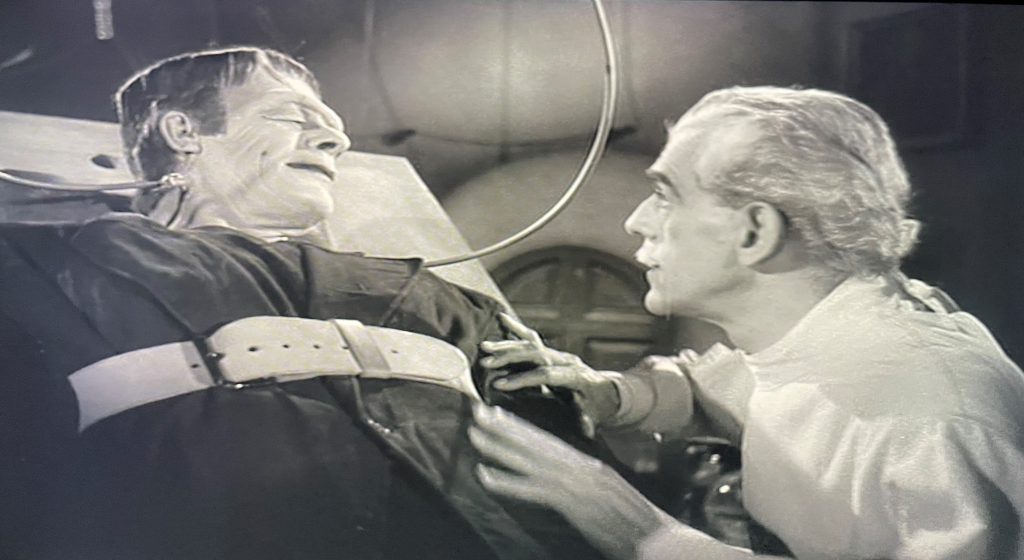
Familiar faces return, even if they aren’t
in familiar roles (that’s Bela Lugosi under the makeup for Frankenstein’s
monster in Frankenstein Meets the Wolf Man).
Actors appear multiple times in the films: all three starred Lon Chaney Jr. (billed without the “Jr.”) as the tragic Lawrence Talbot/Wolf Man; Glenn Strange made two appearances as Frankenstein’s monster; John Carradine was Dracula twice. Character actor Lionel Atwill was in all three playing different officials.
Though these films are not the best Universal offers, they do very well in carrying the look and feel of the studio’s movies. You know you’re watching a Universal film and it feels good. Credit the continuity of the atmospheric look to George Robinson, the director of photography on this trio as well as other Universal horrors like the Spanish-language Dracula (1931), Dracula’s Daughter and Son of Frankenstein (1939). Robinson’s moody use of light and darkness is fantastic especially in House of Dracula where a menacing shadow engulfs a young nurse.
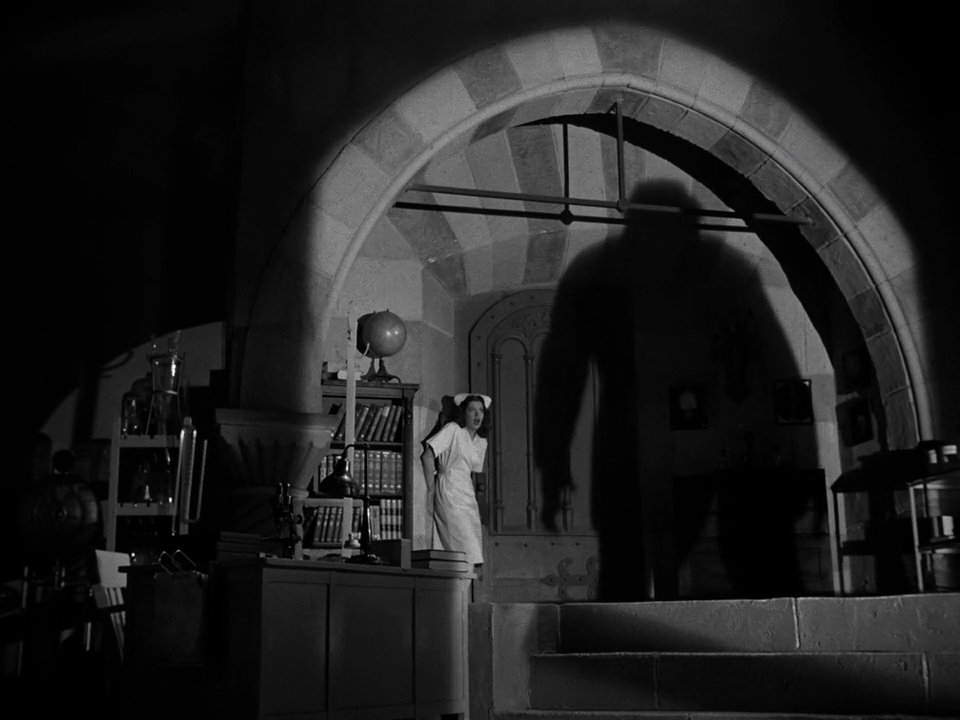
The most fun for me watching these films: the dilapidated ruins of Frankenstein’s castle and the underground caverns that keep popping up with frozen or buried monsters and skeletons like a haunted house attraction.
Not so much fun: the heavy dose of pathos.
Universal was always good at showing the monsters as tragic figures and these
films ramp up the heartbreak.
This is especially true for the pitiful Larry Talbot (the Wolf Man) who is resurrected in each film when all he wants to do is stay dead so he doesn’t kill during the full moon. “Back to a life of misery and despair – I only wanted to die,” he says in House of Dracula, a lament he often repeats.
Frankenstein’s monster is used by deranged men who want to prove the genius of Dr. Frankenstein by perfecting his experiment. Even good-hearted doctors fall under the Frankenstein spell once they realize they are privy to a god-like power to create life. It’s all at the expense of the creature, who is mostly tied to a slab for experiments or fighting to save the doctor who helped him, though it never ends well for this “undying monster.”
Dracula does his thing, but there’s even a
point where he wants to become “normal.”
Here’s a condensed look at the three movies.
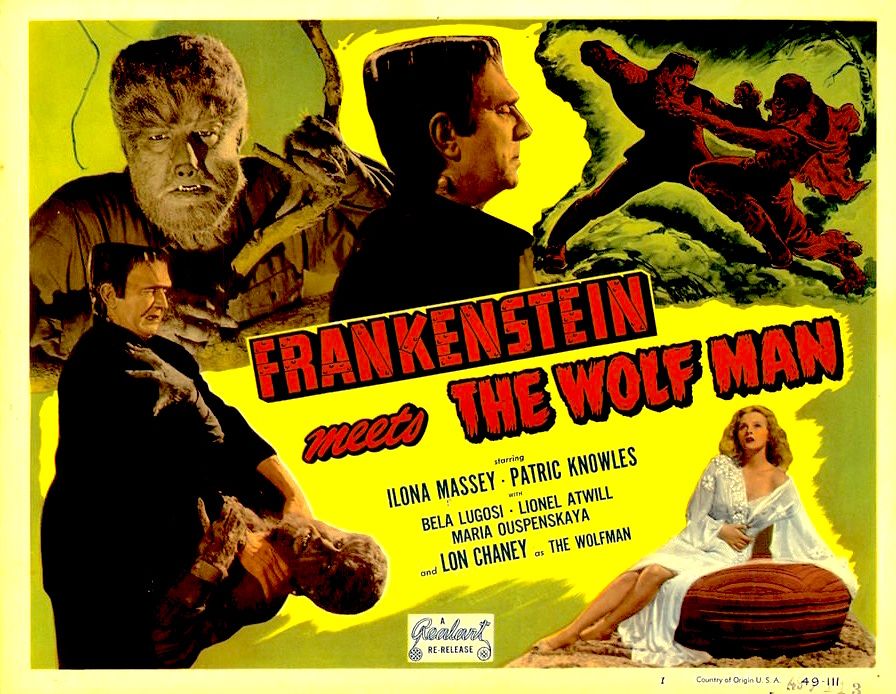
Frankenstein Meets the Wolf Man
Two grave robbers mistakenly resurrect Larry Talbot by removing wolfbane from his coffin during a full moon. When Talbot is found unconscious and bloody in Cardiff, Dr. Frank Mannering (Patric Knowles) tries to help the despondent man. Larry knows his name but is confused over how he got there … since he knows he was dead. (See: The Wolf Man).
Larry runs away after another murderous full moon seeking help from the gypsy Maleva (the welcomed return of the wonderful Maria Ouspenskaya) who mothers him as she talks of a great man who can help – a Dr. Frankenstein. They travel for days, only to learn Frankenstein is dead. Larry is inconsolable, which isn’t helped by another full moon that transforms him once again. Chased by angry villagers, he runs into the ruins of Frankenstein’s castle and falls through the floor where he finds the monster, frozen. A desperate Larry wonders if Frankenstein’s notes may hold a key to his plight and searches for them.
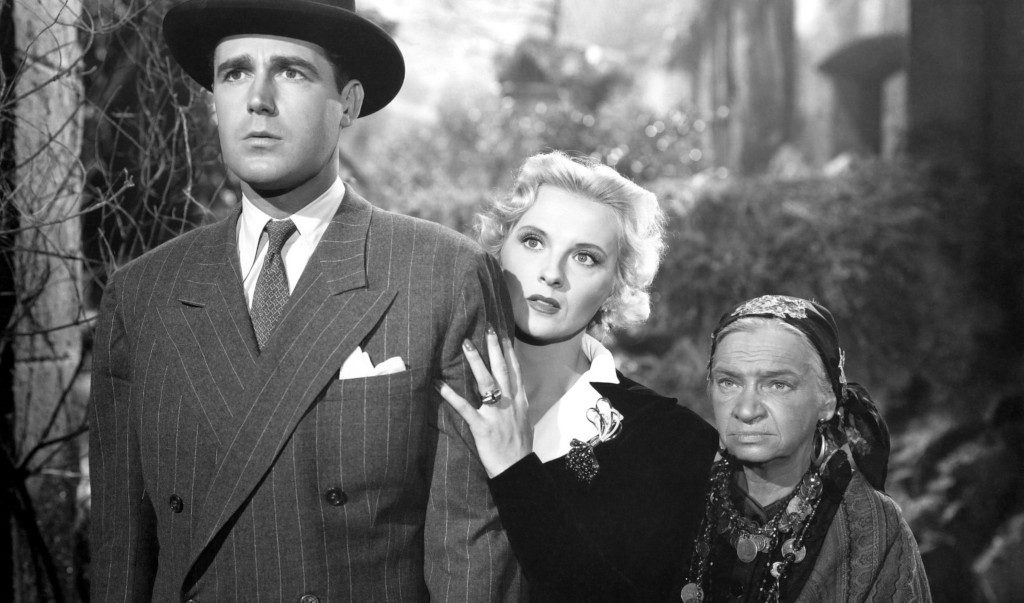
He enlists the help of Elsa Frankenstein (Ilona Massey), granddaughter of the original doctor, and Dr. Mannering who has arrived to convince Larry to return to England. But even good doctor Mannering becomes tempted by helping the creature come alive at its full potential – even if he has to drain the energy from poor Larry. The villagers, who have had enough of the Frankenstein nonsense once again revolt, a dam is blown up and two monsters are left to battle it out leading to ….
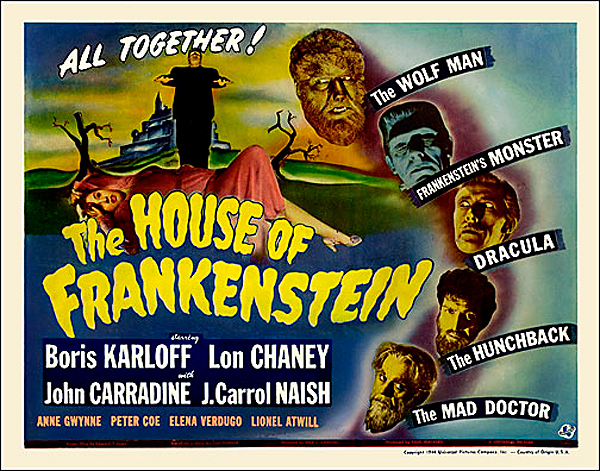
The House of Frankenstein
You get three monsters and essentially two films for the price of one here. They are linked by mad Dr. Gustav Niemann (Boris Karloff) who lives for two things: vengeance on those he blames for his imprisonment and continuing the work of Victor Frankenstein. The movie is surprisingly full of angst and sorrow as two lost souls – one a hunchback and the other a werewolf – each fall in love with the same woman.
As the film opens, Niemann, who is obsessed with Frankenstein, is 15 years into his sentence for experimenting on corpses. He uses chalk on the stone walls of his cell to calculate Dr. Frankenstein’s formulas while promising his “neighbor,” the forlorn hunchback Daniel (J. Carrol Naish) that he can cure him.
After an earthquake makes rubble out of the prison, the two stumble upon the traveling Chamber of Horrors sideshow of Professor Lampini (Universal veteran George Zucco) who claims to have Dracula’s skeleton, complete with a stake in the heart and dirt from Transylvania. (We know it’s not a matter of if, but when, the stake will be pulled to bring Dracula back to life.)
Niemann quickly gets rid of Lampini, takes over his identity and hits the road seeking revenge and Frankenstein’s notebook.
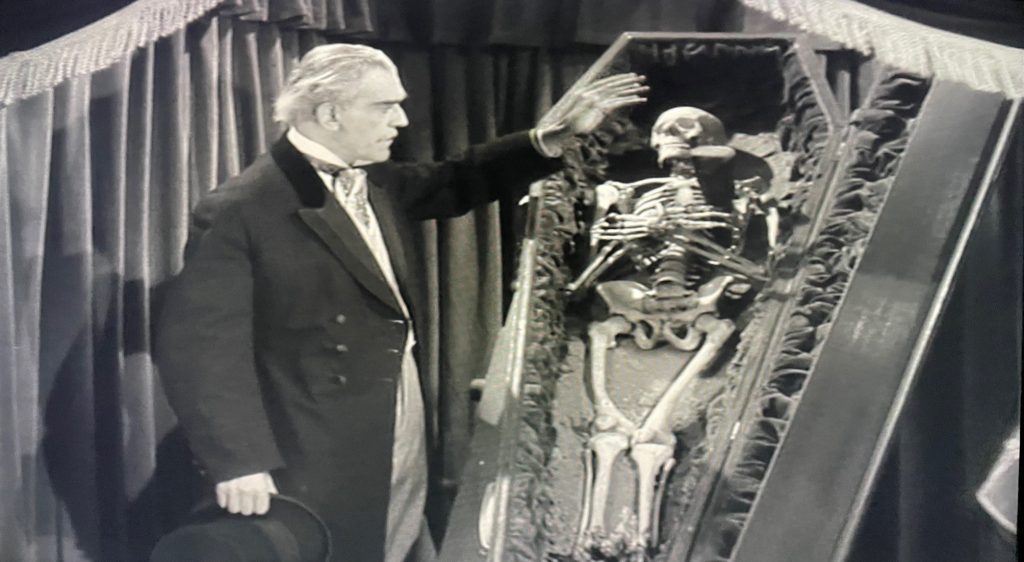
To help him, he awakens Dracula, who honestly isn’t much use after he falls for the first beautiful woman he sees, the granddaughter-in-law of one of the men Niemann wants to kill. Dracula kidnaps her and is chased by authorities. Instead of helping him, Niemann dumps Dracula’s coffin on the road letting the Count fend for himself against the law – and the rising sun.
It’s not even 30 minutes into the movie and
we have to say goodbye – for now – to Dracula. Time for part two.
In a small village, a lovestruck Daniel saves mistreated gypsy dancer Ilonka (Elena Verdugo, “Marcus Welby, M.D.”) and Niemann finds the ruins of Frankenstein’s castle. An icy underground cavern holds the frozen bodies of Frankenstein’s monster (Glenn Strange) and Larry (why can’t they just leave him dead?) where they fell in Frankenstein Meets the Wolf Man. Upon thawing, a despondent Larry begs for the mercy of death which he is promised by Niemann in exchange for Frankenstein’s notebook. That’s a fair trade for Larry.
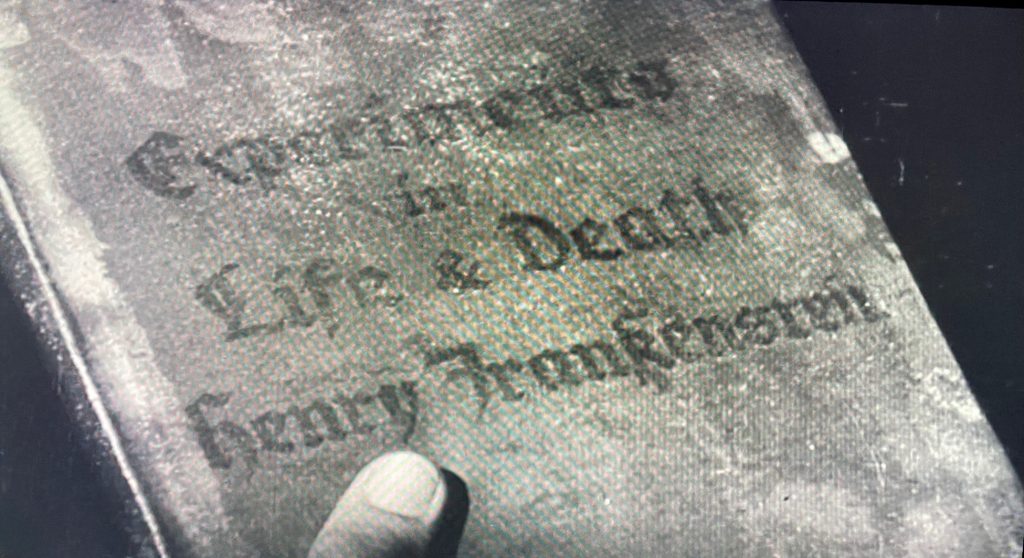
Now with notebook in hand, Niemann returns
to his lab in Vasaria to resurrect Frankenstein’s monster. As Daniel pines for
Ilonka, he realizes she has fallen for Larry. “Why are you always so sad?” she
asks Larry, and not even the truth can sway her. In a very sad scene (“Only
death can give us peace of mind,” Larry says), the star-crossed lovers make a
tragic pact.
Just as sad: Larry and Daniel never had a
chance. As Dracula learned, Niemann will sacrifice everyone for his obsession
with Frankenstein and his creation. Emotions come to a head with the
brokenhearted Daniel blaming the monster for his plight. That’s not going to
end well.
And here come angry villagers with torches once again to chase the doctor and creature out of the castle, this time into a quicksand-filled marsh. Don’t worry, there’s another film and it’s called …
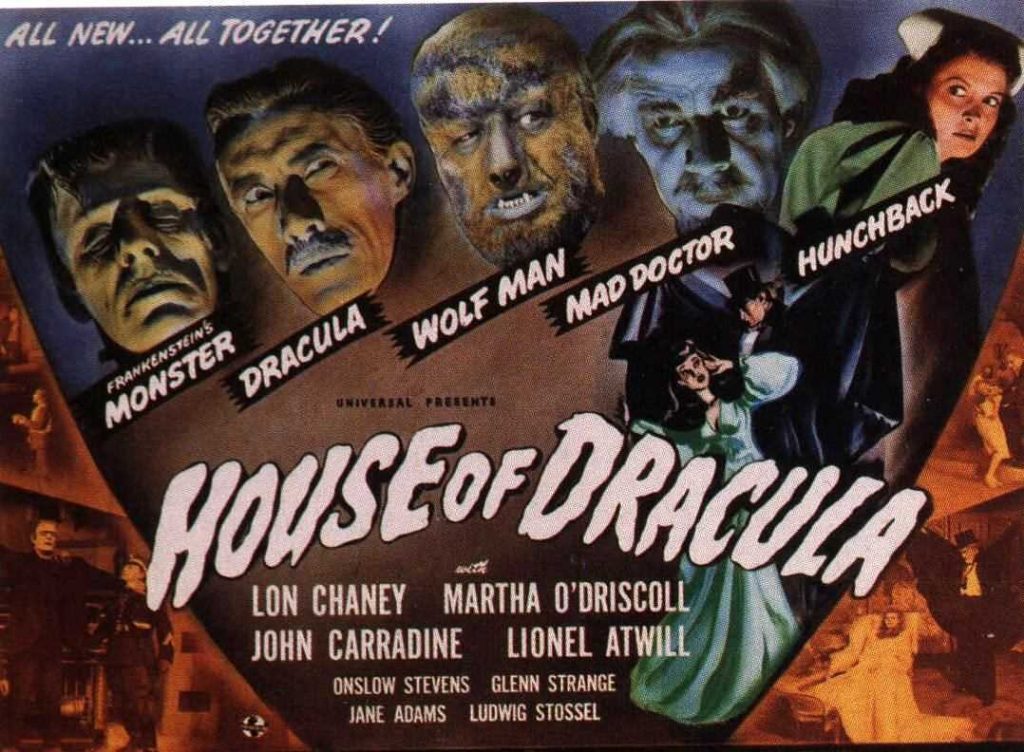
House of Dracula
Imagine this: You wake up at 5 a.m. to find a well-dressed stranger in your room. Instead of screaming, you carry on polite conversation with the man, who asks you to accompany him into your basement. Being a gentleman, you descend the cellar steps with him and find … a coffin.
The gentleman is Dr. Franz Edelmann (Onslow Stevens), the stranger is Count Dracula (Carradine again) who asks for help in seeking “a release from a curse of misery and horror.” (There is no explanation as to how Dracula is “alive,” given the state of his withered hand in House of Frankenstein, nor why he suddenly wants to be mortal.)
Edelmann doesn’t believe in vampires but is intrigued by the idea of making a new scientific discovery. Plus he’s looking for ways to help his kind, hunchbacked nurse Nina (Jane Adams) lose her bump. He has been working with tropical plants in creating a mold that looks promising and perhaps it could help Dracula as well.
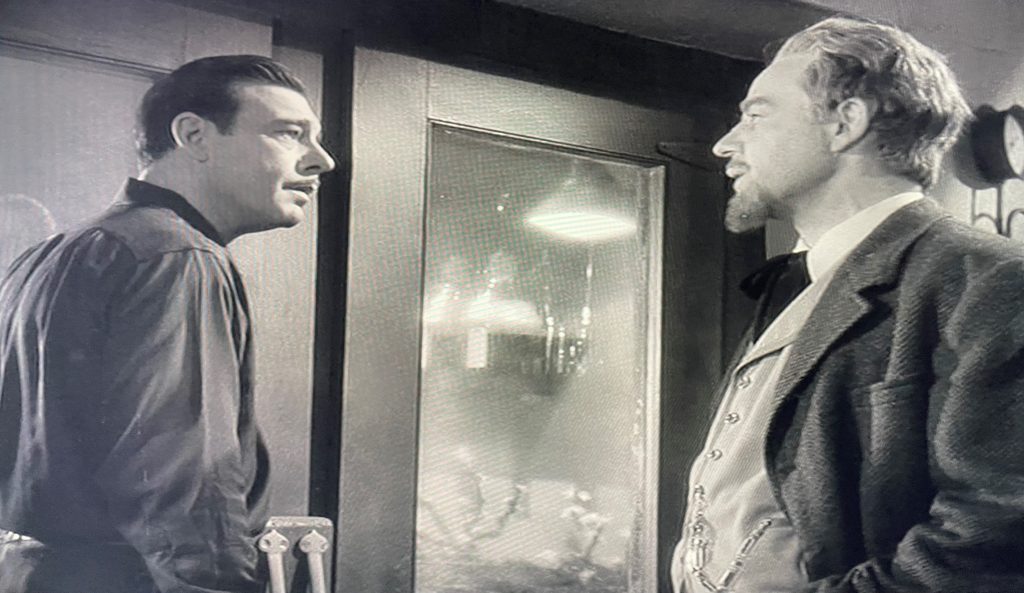
But why only help one creature when you can
help two? Larry Talbot also begs the doctor for help. Through brief testing
(seemingly done by Nurse Nina), Edelmann finds the key to what’s wrong with the
vampire and werewolf: Dracula’s blood has a parasite and Larry has an
overactive gland. Now he can work to save them and Nurse Nina.
Unfortunately Dracula’s darker instincts return when he sees Edelmann’s other nurse is the lovely Milizia (Martha O’Driscoll), a woman from his recent past. The idea of eternal life with the unsuspecting Milizia sets him off and, after a lovely romantic interlude where he ogles her as she plays Moonlight Sonata at the piano by candlelight, Dracula returns to his bad habits. Edelmann is on to him, but the vampire contaminates the doctor’s blood with his own turning him into a Dr. Jekyll and Mr. Hyde hybrid.
The doctor fights it off as much as he can, his better side trying to make enough of his miracle cure to help sweet Nurse Nina and sad Larry. It’s tense waiting to see the outcome.
In one of the most emotional scenes in Universal horror films, Larry walks alone into the garden. With his face a mix of hopefulness and dread, Larry faces the moon. The others anxiously look on as do we to see if enough was done to help Larry. Could he finally be cured or is he doomed? The full moon rises and we get our answer.
* * * *
I would be remiss if I didn’t at least mention a fourth film that could be added to this Universal Monsters Shared Cinematic Universe. The well-regarded and highly entertaining Abbott and Costello Meet Frankenstein (1948) comes with a big dose of comedy, even more familiar faces and is a must-see for Universal fans.
Read more about that comedy in my story: How Abbott and Costello brought the meet-cute to horror.
– Toni
Ruberto for Classic Movie Hub
You
can read all of Toni’s Monsters and Matinees articles here.
Toni Ruberto, born and raised in Buffalo, N.Y., is an editor and writer at
The Buffalo News. She shares her love for classic movies in her blog, Watching Forever and is a
member of the Classic
Movie Blog Association. Toni was the president of the former Buffalo
chapter of TCM Backlot and now leads the offshoot group, Buffalo Classic Movie
Buffs. She is proud to have put Buffalo and its glorious old movie palaces in
the spotlight as the inaugural winner of the TCM in Your Hometown contest. You
can find Toni on Twitter at @toniruberto.









